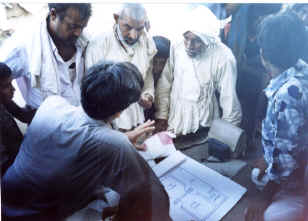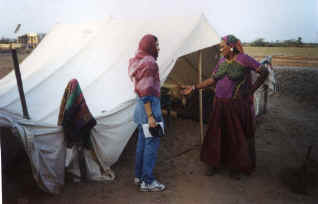Rehabilitation: A
Field Perspective
Kennedy Dhanbalan, eficorhq@vsnl.com
|
EFICOR
is a national relief and development organisation, and has been involved in
relief work for the Earthquake victims at Gujarat. EFICOR is continuing its
involvement through rehabilitation programs in the area. EFICOR in partnership
with Development Alternatives is planning to reconstruct the houses in the three
villages namely Vira, Bitawaladia (East) and Bitawaladia (West) in Anjar taluka,
Kutchchh district.
There are three main stakeholders
in the rehabilitation process. Firstly, it is the community. Secondly, the
Government and thirdly the NGO/s who are operating in the area. The NGOs will
play an important role in the process.
This paper is a reflection on the
experiences in Gujarat as we start the ground work for the rehabilitation phase.
It reflects the conflicts we are facing and derives certain learnings.
Community participation
1. In doing the rehabilitation
work the important thing is to ensure that the community are part of the
planning and decision making. We recognize the community as the primary
stakeholders and the role of the government and the NGOs as supportive. It is
important that the community is taken into confidence in designing the houses
and other infrastructure.
2. Ensuring community
participation through representation of various socio economic sections will be
a precondition for designing, planning, site and material selection, material
procurement, construction, and utilization of resources.
3. Involving women in the
discussions and incorporating their views into the designing of the houses and
other infrastructure will be important. Most of the time they are left out of
important discussions and we wish to reverse this trend.
4. Whenever possible, conduct
separate meetings with each section of the community to get their views, and
ensure that the views of weaker sections are valued and taken into account
adequately.
5. Ensure that the
earthquake-affected members of the community are given the top priority in
skilled and unskilled livelihood opportunities arising during the reconstruction
and rehabilitation process. In doing this, EFICOR is also exploring
possibilities of training the local people, thus building their capacities to
make available building materials (e.g.: hollow and concrete blocks) in the
village itself. This will enable the community to access construction materials,
as well as man power with technical expertise in case the community wants to
extend houses in future.
6. Political affiliations to be
looked into in the community, as this may affect the program. Leaders of each
party should be taken into confidence.
Construction
1. The traditional construction
means, methods, and materials will be taken into account. These could be
forgotten with the anvil of modern construction technologies and material.
2. In reconstruction, the choice
of technology will be based on multiple criteria, including self-reliance of the
community, availability of the material, and earthquake resistant
characteristics.
3. In building the houses, the
cultural pattern of housing will be taken into account.
4. The socio–cultural and
economic aspects are being looked into. The government regulations have given
different packages for different classes. This hinders the process of NGO
involvement in bringing social equality and justice into the rehabilitation.
EFICOR advocates the same in the coordination meetings, and is striving to work
towards it.
Government
1. The government should make
clear policies based on learning from the past experiences.
2. There should also be complete
transparency and accountability from the government in the planning process.
3. Community’s right to
information on the government regulations should be ensured. In doing this,
government officials should be made available to work along with the NGOs in
sharing the information with the community.
4. The government should also
publish regularly, the decisions made, in the leading newspaper in vernacular
languages.
5. The difference from Latur
experience and here is that, the government of Gujarat has come out with
different packages for the villagers on class basis, which does affect the
social equality. This could have been done differently.
6. The government also should
take into confidence the NGOs who are working in the area while bringing in
changes in policy decisions. Certain decisions taken by the government has
brought in adverse impact on the work of the NGOs.
Relocation
1. The Government has given two
options for the villagers in reconstruction.
2. They could either relocate
themselves in a new area, or rebuild in the same place. But a problem is faced
since few families prefer to stay put in the old site itself. We are putting
before the government a third alternative. That is, relocation of the village if
the majority of families prefer that, and in the case of few families who wish
to rebuild in the old place itself, that too should be allowed. Land will be
made available to the families who are relocating in the new site and only their
land in the old site could be taken over by the government.
3. In relocation, each community
in the village should be taken into confidence for relocation. There are
conflicting views in the villages about relocation. In certain villages the
community wants to move out from the original village site as they have lost
their dear ones in that place and want to shift. In others, various views
prevail. They want to stay as the land allocated by the government in the new
site is small, or they have sentimental attachment to the land, which belongs to
their forefathers. Some others have certain structures which are not fallen, and
which they want to use. These views have to be taken into account while planning
for relocation.
4. The scheduled castes,
schedules and nomadic tribes, other socially and economically backward class
communities, should be protected against land alienation.
5. There are strong caste
feelings in the community. This has to be taken into consideration while
designing the village. If overlooked it could create tension in the community.
6. In designing the villages, we need to take
into consideration the cluster method rather than the linear model, which is
normally preferred by NGOs. Its time consuming but
a worthy exercise which gives social stability and support in the
community.
The author is Programme
Coordinator, Relief and Rehabilitation, EFICOR


